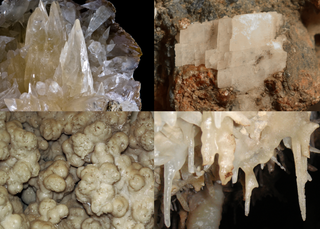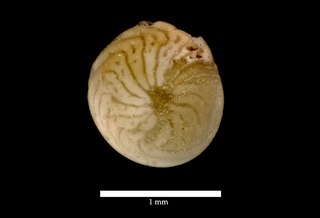
Limestone is a type of carbonate sedimentary rock which is the main source of the material lime. It is composed mostly of the minerals calcite and aragonite, which are different crystal forms of CaCO3. Limestone forms when these minerals precipitate out of water containing dissolved calcium. This can take place through both biological and nonbiological processes, though biological processes, such as the accumulation of corals and shells in the sea, have likely been more important for the last 540 million years. Limestone often contains fossils which provide scientists with information on ancient environments and on the evolution of life.

In geology and mineralogy, a mineral or mineral species is, broadly speaking, a solid substance with a fairly well-defined chemical composition and a specific crystal structure that occurs naturally in pure form.

Calcite is a carbonate mineral and the most stable polymorph of calcium carbonate (CaCO3). It is a very common mineral, particularly as a component of limestone. Calcite defines hardness 3 on the Mohs scale of mineral hardness, based on scratch hardness comparison. Large calcite crystals are used in optical equipment, and limestone composed mostly of calcite has numerous uses.

Ooids are small, spheroidal, "coated" (layered) sedimentary grains, usually composed of calcium carbonate, but sometimes made up of iron- or phosphate-based minerals. Ooids usually form on the sea floor, most commonly in shallow tropical seas. After being buried under additional sediment, these ooid grains can be cemented together to form a sedimentary rock called an oolite. Oolites usually consist of calcium carbonate; these belong to the limestone rock family. Pisoids are similar to ooids, but are larger than 2 mm in diameter, often considerably larger, as with the pisoids in the hot springs at Carlsbad in the Czech Republic.

Foraminifera are single-celled organisms, members of a phylum or class of Rhizarian protists characterized by streaming granular ectoplasm for catching food and other uses; and commonly an external shell of diverse forms and materials. Tests of chitin are believed to be the most primitive type. Most foraminifera are marine, the majority of which live on or within the seafloor sediment, while a smaller number float in the water column at various depths, which belong to the suborder Globigerinina. Fewer are known from freshwater or brackish conditions, and some very few (nonaquatic) soil species have been identified through molecular analysis of small subunit ribosomal DNA.

Gynoecium is most commonly used as a collective term for the parts of a flower that produce ovules and ultimately develop into the fruit and seeds. The gynoecium is the innermost whorl of a flower; it consists of pistils and is typically surrounded by the pollen-producing reproductive organs, the stamens, collectively called the androecium. The gynoecium is often referred to as the "female" portion of the flower, although rather than directly producing female gametes, the gynoecium produces megaspores, each of which develops into a female gametophyte which then produces egg cells.

The Fusulinida is an extinct order within the Foraminifera in which the tests are traditionally considered to have been composed of microgranular calcite. Like all forams, they were single-celled organisms. In advanced forms the test wall was differentiated into two or more layers. Loeblich and Tappan, 1988, gives a range from the Lower Silurian to the Upper Permian, with the fusulinid foraminifera going extinct with the Permian–Triassic extinction event. While the latter is true, a more supported projected timespan is from the Mid-Carboniferous period.

The Rotaliida are an order of Foraminifera, characterized by multilocular tests (shells) composed of bilamellar perforate hyaline lamellar calcite that may be optically radial or granular.

In biology, a test is the hard shell of some spherical marine animals and protists, notably sea urchins and microorganisms such as testate foraminiferans, radiolarians, and testate amoebae. The term is also applied to the covering of scale insects. The related Latin term testa is used for the hard seed coat of plant seeds.

Carterinida is an order of multi-chambered foraminifera within the Globothalamea. Members of this order form hard tests out of thin calcite rods known as spicules, which are held together by a proteinaceous matrix. As of August 2023, the order contains a single family, Carterinidae.

The Asterigerinacea is a superfamily of Foraminifera included in the order Rotaliida, proposed by Loeblich and Tappan in 1988.
Involutinida is an order of foraminifera included in the Spirillinata found in the fossil record from the early Permian to early Late Cretaceous (Cenomanian).
Discorbis is a genus of benthic Foraminifera, that made its first appearance during the Eocene. Its present distribution is cosmopolitan.

The Planorbulinacea are a superfamily of rotalliid foraminifera that has been extant since the Early Cretaceous (Berriasian), characterized by trochospiral tests, at least in early stage but which later may become uncoiled. The test wall is of perforate hyaline calcite, commonly optically radial in structure, with crystallographic c-axes perpendicular to the surface. The apertural face may be imperforate; the aperture interiomarginal and extraumbilical-umbilical to nearly equatorial in coiled forms, subterminal in uncoiled forms.
Globigerinoides is an extant genus of shallow-water planktonic foraminifera of family Globigerinidae. First appearing in the Oligocene these foraminifera are found in all modern oceans. Species of this genus occupy the euphotic zone, generally at depths between 10-50m, in waters which cover a range of salinities and temperatures. They are a shorter lived species, especially when compared to Globorotalia genus. As a genus Globigerinoides is widely used in various fields of research including biostratigraphy, isotope geochemistry, biogeochemistry, climatology, and oceanography.
Globigerinana are free living pelagic foraminiferan, included in the class Rotaliata that range from the Jurassic to recent. Test are commonly planospiral or trochospiral but may be uniserial to multiserial and are of secreted hyaline (glassy) calcite. Chambers are flattened in planospiral forms and spheroidal in trochospiral and serial forms. Some have long radial spines, or needles that may be solidly fixed or moveable in sockets. Gametes are biflagellate and are produced in greater number than by bottom dwelling benthic forms.
The Spirillinata are a group of Foraminifera established by Maslakova, 1990, for spirally wound forms, where the Foraminifera are regarded as a phylum. Two subclasses are included, the agglutinated Ammodiscana and the calcareous Spirillinana.

Globothalamea comprises a class of multichambered foraminifera based in part on SSU rDNA evidence; the other is Tubothalamea.
Stercomata are extracellular pellets of waste material produced by some groups of foraminiferans, including xenophyophoreans and komokiaceans, Gromia, and testate amoebae. The pellets are ovoid (egg-shaped), brownish in color, and on average measure from 10-20 μm in length. Stercomata are composed of small mineral grains and undigested waste products held together by strands of glycosaminoglycans.

Foraminiferal tests are the tests of Foraminifera.












